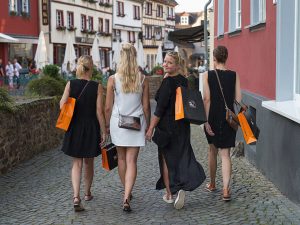
Image Source: Business Insider
Swipe left to reject, swipe right to show you’re interest; then another profile comes up because maybe, just maybe this guy is better than the last. However, it seems as if Tinderization is not only affecting dating, but also the way we shop in today’s globalized, diverse, and dynamic market environments. Just like with Tinder, where will always be a brand that shows up right after you swipe right. With so many choices, shoppers are constantly faced with the sense of a possibility of a better deal, leading “to a sharp decline in brand loyalty”3. The attention span of consumers shorten and consumers now prefer to purchase goods at a time of need or want rather than in event cycles.3
I believe the ‘Tinderization of retail’3 brings a greater importance to the positioning of a company or product and to the comprehension of a company’s positioning within the market. Al Ries and Jack Trout4 has already stated that getting into a customer’s mind is very important. Being first will give a company a greater advantage4. Because our markets are now so dynamic and that consumers have a shortening attention span, I think companies will need to find more effective ways to constantly change their marketing techniques. The life-span of certain competitive advantages which a company attains in terms of marketing and promotion may be shortening as consumers will get bored of new promotions faster with their shorter attention span. Companies need to consider Transient Advantage2, and they will have to launch competitive cycles quite frequently.

Image Source: Business Insider
Tinderization has probably been a big factor to the shift of customer behavior and decision making from the Tunnel Analogy to a more cyclic model (like the McKinsey model1). Because new, and potentially better, options are constantly being introduced to the consumer, the number of companies that the consumer considers is constantly changing until the consumer decides on one brand, but even after purchase, the consumer’s evaluation of a brand is still ongoing as the consumer creates expectations with the vast amount of new information he or she receives after purchase. However, Tinderization seems to be beginning to lead consumers away from the loyalty route and bring them back to the active evaluation phase of the McKinsey Model. Because trends, news, and preferences are changing at an increasing rate, the expectations consumers create after purchase may not match the company’s brands unless the company modifies its brands to be able to chase consumer’s metamorphosing needs. Points of parity and points of differences must be assessed carefully within a company in order to sustain consumer loyalty.
Word Count: 430
References
1 Court, David, et al. “The Consumer Decision Journey.” McKinsey & Company, June 2009, www.mckinsey.com/business-functions/marketing-and-sales/our-insights/the-consumer-decision-journey. Accessed 15 Oct. 2016.
2 McGrath, Rita Gunther. “Transient Advantage.” Harvard Business Review, PDF ed., 2013, pp. 62-70.
3 Peterson, Hayley. “Tinder Culture Has Taken Over, and Now It’s Killing Retail.” Business Insider, 15 Oct. 2016, www.businessinsider.com/tinder-culture-is-hurting-retailers-2016-10. Accessed 15 Oct. 2016.
4 “Product Positioning.” Quick MBA, International Centre for Management and Business Administration, 2010, www.quickmba.com/marketing/ries-trout/positioning/. Accessed 15 Oct. 2016.
Image Source
“Getty Images.” Business Insider, 15 Oct. 2016, www.businessinsider.com/tinder-culture-is-hurting-retailers-2016-10. Accessed 15 Oct. 2016.
Rentz, Andreas. “Andreas Rentz/Getty Images.” Business Insider, 15 Oct. 2016, www.businessinsider.com/tinder-culture-is-hurting-retailers-2016-10. Accessed 15 Oct. 2016.